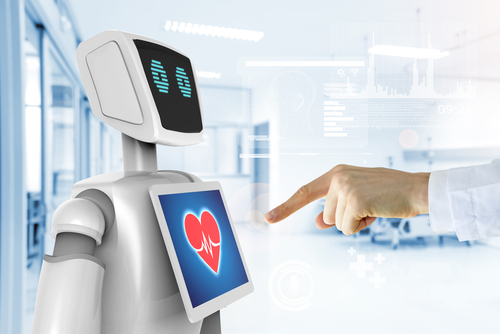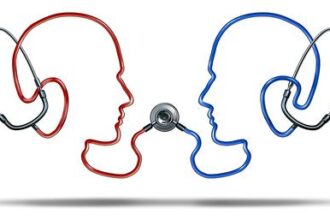Health care providers have become increasingly dependent on technology over the last few decades, with electronic records, heart monitors, and laparoscopic procedures replacing (or supplementing) handwritten forms, stethoscopes, and invasive open surgery. But there’s more change in the pipeline.
The medical profession is now starting to take the next step by adopting even more sophisticated solutions that involve automation, robotics, and artificial intelligence. Doctors, nurses, therapists, pharmacists, and administrators all hope that new techniques and equipment can help them save lives and improve care while also trimming costs over the long run.
Patient contact
One of the most basic components of healthcare is human contact – that is, interaction between people who need care (patients) and people who can provide care (providers). But interaction doesn’t consist only of face-to-face meetings. Since the late 19th Century, the definition of the word has expanded to include telephone calls. Within the last few decades, it has expanded again to encompass email messages and internet forms.
And now the Fourth Industrial Revolution is paving the way for additional expansion. Patients are not just interacting with providers and support staff but also with machines. When they enter a doctor’s office, they can use smart devices to create or update medical records. When they can’t visit a care provider in person, they can use remote conferencing solutions to initiate discussions or exchange data. When they enter a surgical theater, their doctors may be in another room, sitting at the controls of a robotic apparatus equipped with an augmented reality display rather than standing at the ready with scalpel in hand. When they show up for a physical therapy appointment, they may make use of automated solutions rather than relying purely on bodily support from therapists and stationary equipment.
For the last decade, researchers at the Biorobotics Laboratory, a division of the Ecole Polytechnique Federale de Lausanne (EPFL) in Switzerland, have been working to develop such solutions for use in locomotion therapy. For example, they have worked with Symbitron to design and test robotic exoskeleton frames that provide paraplegic patients with mobility. They have also drawn on their knowledge of biological systems to develop neuromuscular controls for users of these frames.
These solutions have the potential to push the field of rehabilitation therapy far beyond current limits. In the words of the Robotic Industries Association: “With further refinement, medical robots may have the capacity to not only enhance recovery, but restore agency to the disabled.”
Administrative matters
New technologies are also having an impact on the administrative side of health care.
As mentioned above, providers can use Internet of Things (IoT) devices to collect, organize, and store patients’ data. But they also have the option of using smart devices to keep track of inventory and automate the ordering and delivery of new stock, thereby reducing the likelihood that they will run out of mundane yet critical items such as gauze and gloves.
Additionally, they now have the ability to automate pharmaceutical functions – namely, filling prescriptions and dispensing medications. Robotic prescription dispensing systems are often a boon for care providers because they are less prone to errors in dosage and distribution than human technicians. They also give pharmacists more time to address compounding, clinical services, and other tasks that benefit from human judgment and insight.
Earlier this year, Tom Gierwatoski, RPh told Modern Medicine Network that Platte Valley Pharmacy in Brighton, Colorado, had reaped significant benefits from its installation of a ScriptPro dispensing robot three years before. He explained that automation had allowed the facility to fill 50% more prescriptions, devote more time to compounding, and offer more clinical services such as diabetic shoe fitting, all while reducing the number of technicians on staff by around 50%.
Emergency situations
New technologies also give health care providers more convenient ways to handle emergencies.
For example, hospitals can contain bacteria and other contagions by sending robots equipped with ultraviolet lights and cleansers such as hydrogen peroxide or chlorine bleach to sterilize surfaces. This can help slow the spread of disease and minimize public exposure to infectious agents.
The University of Vermont Medical Center (U-V) has been using this type of technology since 2015, when it purchased two robots from Xenex Distribution Services. Sally Hess, U-V’s manager of infection prevention, told Modern Healthcare in 2015 that these units had added “an extra layer of protection” to the hospital’s efforts to reduce contagion, while also reducing the impact of human error. “There’s no question they kill bugs,” she added.
R&D
Technology can also give a boost to medical research programs.
On the operational side, researchers can use robots to automate tasks that are repetitive, dangerous, or requiring high levels of precision. And on the analytical side, they can use machine learning or other artificial intelligence solutions to review, find patterns in, and draw conclusions from large sets of data.
Memorial Sloan Kettering Cancer Center in New York is one of the health care facilities that has embraced Big Data. Earlier this year, researchers affiliated with the hospital published an article about using a supercomputer to analyze a large amount of data – namely, more than 44,000 glass-slide images of tissue samples taken from more than 10,000 patients. According to the article, deep-learning techniques allowed the computer to identify close to 100% of the cancerous samples correctly.
Dr. Thomas Fuchs, a data scientist working at Memorial Sloan Kettering, said the study showed that technology could serve as a powerful diagnostic tool. “We have built a model that can detect cancer with great accuracy, in line with what you would find with trained expert pathologists,” he said. “This novel machine-learning system could potentially be used by pathologists everywhere to help them make more accurate diagnoses.”
Dr. Fuchs also pointed out that the use of deep-learning techniques had been critical to the study’s success, explaining that previous attempts to computerize the diagnostic process had been much less successful. “It’s like training a self-driving car in an empty parking lot,” Dr. Fuchs says. “It may work at first, but as soon as you hit Manhattan, it will fail drastically.”
Conclusion
Robotics, automation, and new technologies such as smart devices have already made a difference in the health care field. They have given providers new ways to interact with patients, handle emergencies, and manage administrative tasks, and they are becoming invaluable tools for medical researchers. And as technology continues to develop, they are sure to become even more important.








